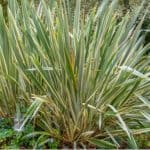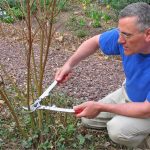Last updated on April 27th, 2022
Our site is reader supported, this means we may earn a small commission from Amazon and other affiliates when you buy through links on our site.
Hebes are evergreen shrubs that do quite well in the UK given their hardiness, their low maintenance requirements because they require minimal pruning. They prefer being in full sun all year round but can tolerate semi-shade if that is all you have, just note that in semi-shaded areas they might not flower as prolifically as they would in a full sun position.
They’re very flexible in that you can grow them in the ground and they also grow very well in container and pots of many sizes, although some varieties are better suited to pots than others, however, the vast majority of varieties will grow well in containers. They do best with well-draining soil but beyond that can grow in lighter, sandy soils or heavier, clay soils as long as the soil does not become waterlogged, don’t forget to dig plenty of grit into clay soil to help with drainage.
They also tolerate slightly acidic through to slightly alkaline soil conditions. There are also variegated varieties and some that produce very attractive flowers, ranging in colour from deep purples and whites to pinks and blues. You can also enjoy multiple sizes depending on the space you have available because some varieties reach around 30cm by 30cm and are perfect for pots while others can reach a height and spread of 4-5ft.
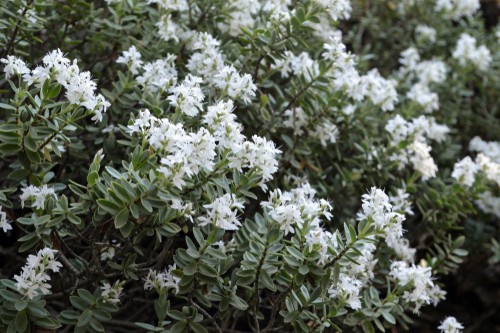
Caring for Hebes
Hebes are low maintenance so you only need to do a few things to keep them happy.
- Firstly, check for signs of damage from frost in March. If any stems have been damaged, remove them back to the point of a healthy bud. This is the same process you want to take when you prune them annually as well after they have finished flowering.
- If your Hebe is currently flowering, make sure you deadhead after flowering to extend the flowering period.
- If you are growing Hebes in the ground, don’t give them nitrogen-heavy fertilisers and add some bone meal in April and July instead.
- Water during the dry periods, especially if you are growing them in containers because they can suffer and lose their lower leaves.
Pruning Hebes
It will do your plant the world of good to prune it annually, but it’s not essential. This keeps it reasonable in its size, especially if you have a taller variety and it prevents a lot of crowding around the middle of the plant which usually leads to problems of air circulation and diseases. If you don’t prune on an annual basis eventually your plants will become bare around the base and all of the foliage will be up at the top. This eventually causes the stems to bend over under the weight and you lose that bushy appearance.
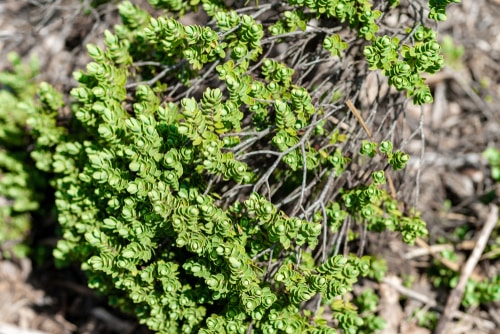
When to prune
March is the best time to prune because the new buds will be visible so you won’t damage them.
Don’t prune into the old wood
You don’t want to prune back into the old, dead wood. Instead, you want to prune back until you still have a few buds present on every stem. With compact varieties like the Hebe ‘Green Globe’, you also want to prune to maintain their shape by removing the top 5-10cm every year.
Pruning larger varieties
If you have a larger variety you can prune back the top 20cm-30cm every year and maybe even prune a few stems back further to open up the middle and allow better air circulation.
Growing Hebes in containers and pots
You can certainly grow these shrubs in a container and they also look great in the winter because they are evergreen. When growing them in pots, the main concern is making sure that you add enough compost to keep the soil moist but never waterlogged. You should apply a feed to the plant between April and September in two months intervals, which includes a small handful of bone meal worked into the compost.
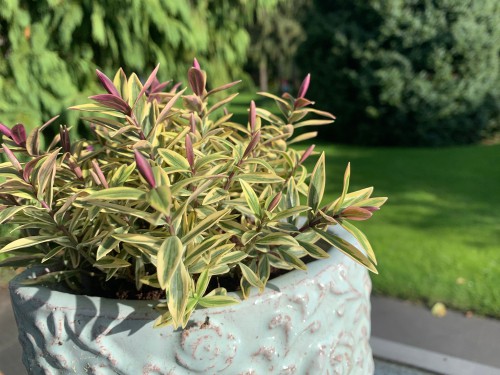
Winter protection
Come winter it’s important to put your container somewhere they are out of direct winds and have some protection against frost. This is usually against the wall of your home or in an unheated greenhouse. Make sure you purchase a variety that is suitable for growing in containers as well, not all will grow in happily in containers, especially the larger varieties.
Potential diseases when growing Hebes
These shrubs are remarkably healthy and they don’t suffer from a lot of diseases but there are a few things you need to look out for.
Leaf Spot
Leaf spot is one thing to keep your eyes peeled for and it’s something that manifests in the form of small brown spots or marks on the leaves. It’s not an immediate threat to your plant but if you don’t treat it, it will reduce the vigour, the overall health and your plant will get leggy.
This is a fungal disease that usually manifests between October and February. By the time March rolls around the new leaves that are developing will force the older leaves to shed. The best treatment is to apply a general-purpose fungicide in September or as soon as you notice the issue has manifested. You might have to give two or three applications every two weeks until the problem is solved.
Downy Mildew
Downy mildew is another problem you have to worry about. The symptoms manifest in the form of irregular brown marks along the top of your leaves and you might notice grey fungal growth on the underside. With this disease, it usually impacts the lower leaves more than the leaves on top because it’s caused by damp conditions, lack of air circulation, and cold soil.
The only way to really take care of this disease is to prevent it in the first place. Make sure you prune in order to improve air circulation and if absolutely necessary, add mulch around the base of the plant to help keep the roots warm, especially when the weather gets colder, and check on your plant when there are damp conditions outside. You might be better off moving your plant to somewhere sunnier because this disease will eventually kill your plant if you don’t deal with it. You can also try spraying your plant with a fungicide at first signs, however, prevention is better, which means improving the growing conditions.
Root Rot
Similarly, root rot will kill the entire plant if left to its own devices. It slows down the growth and is usually the result of poor soil, bad drainage, or cold weather. There is no cure for this but you need to improve the soil conditions and try to prevent it. If you notice your plant is turning brown and dying off the best option is to simply dig it up and start over in a different location with a new plant because they very rarely recover.
How to propagate Hebes by taking cuttings
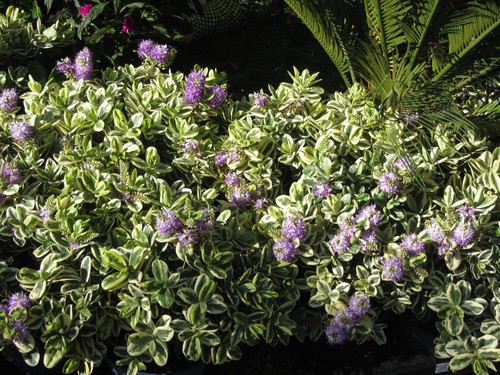
When to take cuttings
Hebes are best propagated from semi-ripe cuttings. These are cuttings you take between July and September. It is important to find stems that are hard at the base and soft at the tip, hence the name.
Taking cuttings
Take cuttings that are between 10cm and 15cm long, and only pick horizontal untainted pieces. Avoid anything that is atypical in shape, unhealthy, or anything other than top-notch.
Tip: The best cuttings are those at the top of your Hebe, the ones with full sun exposure and no flowers.
Step 1
When cutting, use a sharp, sanitised knife or garden secateurs and cut directly below a leaf node/bud. Trim the lower leaves away as well so that only four leaves remain at the top. It is from the bottom of the cutting that the roots will grow.
Step 2
It is important to pot these cuttings immediately for the best chances of them rooting. Before you place the cuttings into the containers it is important to dip the end in rooting hormone powder.
Step 3
To prepare the containers, find appropriately-sized containers that are not too large or plug trays and fill them with a potting compost mixture. Insert a stick, pencil, or pen to create a hole straight down in the middle into which you will place the cuttings. Each cutting should have its own container and once it is in place and firmly patted down, water it thoroughly and allow the water to drain all the way through so that the soil is thoroughly saturated.
Step 4
With this, you want to be sure you are creating a miniature greenhouse which is why the propagating kits you see in garden centres tend to have a large tray and a top often with air vents. The top pieces are plastic and are often adjustable.
If you don’t have a propagator you can recreate one at home using a plastic bag or a plastic cup with holes in the bottom, you can use any material as long as the material you use does not come into direct contact with the leaves. You can help this by tenting the plastic bag using things around the house like flower sticks, canes, chopsticks, and pencils.
Step 5
The containers should be kept in a greenhouse or a warm area where it receives indirect sunlight, for example, on a windowsill. After about 4 weeks your Hebe cuttings should have rooted, however, it can take longer so be patient.
Step 6
In the spring of the following year, you can pot them into larger containers, about 2 litres in size and keep them well watered. When the beginning of September arrives, you can plant them outside or in a large container that will serve as their final home.
Learn more about propagating Hebes from cuttings in this guide
Our top varieties
There are, of course, many sizes and shapes for Hebes. This is why we’ve compiled a quick list of our top varieties for small, medium, and larger-sized Hebes.

Small Hebe
Name: Hebe ‘Wild Romance’.
Height and spread: 60cm.
Leaf colour: Dark and light green, black and purple top growth.
Flowering: Purple flowers from July through September.
Growth habit: Round, compact bush.
Can it endure the UK frost? No, needs protection during freezing temperatures.
Can it grow well in containers? Yes.
Medium-sized Hebe
Name: Hebe ‘Heartbreaker’.
Height and spread: 75cm.
Leaf colour: Glossy green leaves that turn red in winter, evergreen shrub.
Flowering: White spikes flowers from June and July.
Growth habit: Compact, dome shape.
Can it grow well in containers? Yes.
Larger-sized Hebe
Name: Hebe ‘Midsummer Beauty’.
Height and spread: 2-3 metres.
Leaf colour: Dark green on the top with shaded purple underneath.
Flowering: Lilac flower spikes that fade to white from July to October.
Growth habit: Rounded, loose shrubs.
Can it grow well in containers? Better suited for growing in beds and borders but will tolerate a large pot if needed.
Last update on 2025-12-17 / Affiliate links / Images from Amazon Product Advertising API

